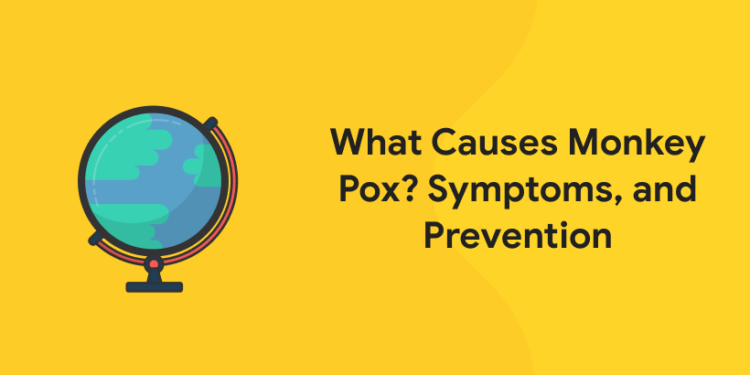Table of Contents
Monkeypox was found in 1958 when two outbreaks of a pox-like disease occurred in troops of monkeys being used for research. It is transmitted mainly through human contact with infected rodents, but can also be spread through skin-to-skin contact with an infected person. There are two known categories (clades) of monkeypox virus — one that is originated in Central Africa and one that is originated in West Africa. The current world outbreak (2022) is given rise to by the less severe West African clade.
Monkeypox cases have been reported in several countries during the month of May 2022. There has been a rapid outspread of the virus across Europe and North America. The United Kingdom (UK) has reported 20 cases of the rare virus since the first week of May 2022.
Since 13 May 2022, cases of Monkeypox have been reported to WHO from 12 Member States that are not natives for the Monkeypox virus across three WHO regions.
The World Health Organization (WHO) has required for an emergency meeting to discuss Monkeypox and focus on the transmission and vaccines of this virus.
Attempt Free GK Test! Download Entri App!
How common is Monkeypox?
Monkeypox is a rare disease that mainly occurs in West and Central Africa, often in vicinity to tropical rainforests. However, the number of cases is increasing in Africa, as well as those urban regions that have not spotted these infections before.
With 80 per cent of cases in European countries, the WHO confirmed the global outbreak of Monkeypox and sounded its highest level of alert for the disease proclaiming the virus as a Public Health Emergency of International Concern (PHEIC).
The symptoms of Monkeypox are similar to smallpox but are more lenient. Rarely fatal, this disease is not related to chickenpox.
Where else is monkeypox found?
For decades, Monkeypox was mostly seen in Africa. However, it is occasionally seen in other countries, including the United States. In the spring of 2003, the first outbreak of monkeypox outside of Africa took place in the United States. A shipment of infected animals from Ghana was brought into Texas. The infected rodents spread the virus to pet prairie dogs, which then contaminated 47 people in the Midwest.
As international travel becomes more common, viruses that were once fairly limited to certain locations can more easily expand around the world. In the summer of 2021, a case of monkeypox was found in a U.S. resident who had traveled from Nigeria to the United States. Then, 2022 brought outbreaks to domains outside of Africa, including Europe, the Americas and Australia.
Who does Monkeypox affect?
1: Who was the first woman President of India?
While most of the cases are among children aged below 15 years in Africa, people from any age group can be affected Monkeypox disease. Outside Africa, the disease seems to be more common in men having sexual intercourse with men. However, there are several cases seen in individuals who do not fall into this category.
Free UPSKILLING Courses!
Take your first step toward mastering in-demand skills, acing interviews, and securing top-tier jobs with Entri's free upskilling courses.
Start Learning!What Causes Monkeypox?
Monkeypox is caused by the Monkeypox virus, a double-stranded DNA virus (genus Orthopoxvirus of the Poxviridae family). According to the CDC, the virus is closely related to other ‘pox’ viruses like:
- Vaccinia (used for smallpox vaccine)
- Variola major and minor (that cause smallpox)
- Cowpox virus
The virus (found mainly in tropical rainforest regions of West and Central Africa) was first detected in captive monkeys. The two sub-types of the virus are Congo Basin and West African clades that match the geographical regions.
Along with monkeys, the virus was also detected in African squirrels and Gambian pouched rats. The use of these animals as food could be a vital source of transmission to humans.
Attempt Free GK Test! Download Entri App!
Humans can be infected by an animal via:
- A scratch/bite
- Bushmeat preparation
- By contact with the bodily fluids or lesion material of an infected animal
The virus is said to enter the body through the respiratory tract, broken skin, or the mucous membranes of the mouth, nose or eyes.
Once an individual is infected, transmission to others is common, family members as well as hospital staff are mainly at risk of infection. The virus can be contagious by airborne (respiratory) contact or by direct contact with the bodily fluids of an infected person.
There are certain signs which shows that transmission can happen during sexual contact or due to indirect contact with lesion material like contaminated bedding. Risk factors for spread include using a bed or room of the infected person, or using the same utensils used by the infected person. Increased transmission risk is associated to factors involving the introduction of virus to the oral mucosa.
Symptom and Causes
What are the signs and symptoms of monkeypox?
After exposure, it may be several days to a few weeks before you develop symptoms. Early symptoms of monkeypox consists of flu-like symptoms like:
- Fever.
- Chills.
- Headache.
- Muscle aches.
- Fatigue.
- Swollen lymph nodes.
After a few days, a rash mostly develops. The rash begins as flat, red bumps, which can be painful. Those bumps change into blisters, which fills with pus. Eventually, the blisters crust over and fall off — the whole process can last two to four weeks. You can also get sores in your mouth, vagina or anus.
Not everyone with monkeypox shows all of the symptoms. In fact, in the current (2022) outbreak, a lot of cases aren’t following the usual pattern of symptoms. This atypical presentation consists of only a few lesions, no swollen lymph nodes, less fever and other signs of illness. You can have it and be unaware of it. But even if you don’t show many signs of infection, you can still spread it to others through prolonged close contact.
The disease can be classified into two periods:
- The invasion period, which lasts between 0–5 days, is distinguished by intense headache, fever, back pain, swelling of the lymph nodes (lymphadenopathy), muscle aches (myalgia) and lack of energy (intense asthenia). Compared to other diseases that may at first look similar (smallpox chickenpox, measles), lymphadenopathy is a distinctive character of Monkeypox infection.
- Usually, the skin eruption begins within 1–3 days of the advent of fever. The rash is likely to be more focused on the face including the extremities rather than on the trunk. It affects the palms of the hands and soles of the feet in 75% of cases and in the face in 95% of cases. It also affects the oral mucous membranes in 70% of cases, genitalia in 30% and conjunctivae in 20% of cases, including the cornea. The rash develops sequentially from lesions with a flat base (macules) to slightly raised firm lesions (papules), lesions filled with clear fluid (vesicles), lesions filled with yellowish fluid (pustules), and crusts that dry up and fall off. The number of lesions changes from a few to several thousand. In many cases, lesions may coalesce until large sections of skin slough off.
Normally, Monkeypox is a self-limited disease with symptoms lasting for 2 – 4 weeks. However, extreme cases may occur more commonly in children and are linked to the patient’s health status, the nature of complications and the extent of disclosure to the virus. Any underlying immune deficiencies may result in worse outcomes.
While vaccination against smallpox was protective before, today people below 40 to 50 years of age, depending upon their country, may be more open to Monkeypox disease due to the end of smallpox vaccination campaigns worldwide after the eradication of this disease.
The fatality ratio of Monkeypox disease has ranged historically from 0 – 11% in the general populace and has been more among young children. However, the case fatality ratio has been around 3 – 6% in latest times.
How do you catch monkeypox?
Monkeypox is transmitted when you come into contact with an animal or a person infected with the virus. Animal-to-person transmission happens through broken skin, like from bites or scratches, or through direct contact with an infected animal’s blood, bodily fluids or pox lesions (sores).
Monkeypox can spread from person to person, but it’s less common. Person-to-person spread (transmission) happens when you come in contact with the sores, scabs, respiratory droplets or oral fluids of an infected person mostly through close, intimate situations like cuddling, kissing or sex. Research is ongoing, but researchers haven’t confirmed if the virus is transmitted through semen or vaginal fluids.
You can also get monkeypox by being in contact with recently contaminated materials like clothing, bedding and other linens that have been used by an infected person or animal.
Attempt Free GK Test! Download Entri App!
Animal-to-human transmission
Monkeypox can spread from animal to human from a scratch or a bite, direct contact with the blood, bodily fluids or pox lesions (sores) of an infected animal, or indirect contact with lesion material, like contaminated bedding and bushmeat preparation. The term ‘bushmeat’ applies to raw or minimally processed meat that are from wild animals.
Human-to-human transmission
Monkeypox is said to spread from human to human largely through large respiratory droplets. Normally, respiratory droplets cannot travel more than a few feet. Therefore, prolonged face-to-face contact is necessary for the virus to be contagious. Human-to-human transmission can also take place when a person comes in contact with the sores, scabs or oral fluids of an infected person mainly through close, intimate situations such as cuddling, kissing or sex. Studies are underway but researchers are not positive if the virus can transmit via semen or vaginal fluids. Other human-to-human transmission modes consist of indirect contact with lesion material such as linen and clothing contaminated by the virus.
Monkeypox usually lasts 2-4 weeks and can spread from the time symptoms start growing until the rash has completely healed and a fresh layer of skin is formed. Asymptomatic people or those who do not have Monkeypox symptoms and cannot transfer the virus to others.
While African rodents are reckoned of playing a role in the spread, the Monkeypox virus’s main disease carrier (or the reservoir host) is still undetermined.
Free UPSKILLING Courses!
Take your first step toward mastering in-demand skills, acing interviews, and securing top-tier jobs with Entri's free upskilling courses.
Start Learning!Diagnosis and Tests
How is monkeypox diagnosed?
As Monkeypox is a rare disease, your doctor may first think of other rash diseases like smallpox, chickenpox or measles. Although, swollen lymph nodes (lymphadenopathy) usually differentiate Monkeypox from other poxes.
To detect Monkeypox, the healthcare worker takes a tissue sample from the open lesion (sore) of an infected person and carries it safely (in accordance with national and international requirements) to a laboratory with suitable capability. Polymerase chain reaction (PCR) is the most favoured lab test given its sensitivity and accurateness. Then, the infected person may have to provide a blood sample to check for the Monkeypox virus or antibodies their immune system makes to it.
Management and Treatment
Is monkeypox curable?
Monkeypox is generally a self-limited disease with symptoms lasting from two to four weeks. Most people with monkeypox recover on their own without treatment. Following diagnosis, your healthcare provider will observe your condition and try to reduce your symptoms, prevent dehydration and provide antibiotics to treat secondary bacterial infections if they increase.
Currently, there aren’t any approved antiviral treatment for monkeypox. Antiviral drugs may help, but they haven’t been announced as a treatment for monkeypox. Several investigational antivirals with activity against monkeypox are at hand, but only as share of a research study.
What is the Treatment for Monkeypox?
Currently, there are no proven Monkeypox-specific treatment. Antiviral medications might be useful, but they have not been declared as a treatment for Monkeypox.
However, as smallpox and Monkeypox viruses are genetically similar, antiviral medicines and vaccinations made to cure patients from smallpox infection can be used to avoid and treat Monkeypox virus infections.
Antiviral medications like tecovirimat (TPOXX), can be suggested for people who are prone to getting extremely sick, such as patients with weakened immune systems.
If you are showing Monkeypox symptoms, you should talk to your doctor immediately, irrespective of whether you have been in contact with those with Monkeypox or not.
Prevention of Monkeypox
How do you prevent monkeypox virus?
A smallpox vaccine gives protection against monkeypox, but its use is currently restricted to clinical trials. Prevention relies on preventing human contact with infected animals and restricting person-to-person spread. The best way to help avoid spreading the monkeypox virus is to:
- Avoid contact with infected animals (especially sick or dead animals).
- Avoid contact with bedding and other materials contaminated with the virus.
- Properly cook all foods that consist of animal meat or parts.
- Wash your hands regularly with soap and water.
- Avoid contact with people who might be infected with the virus.
- Practice safe sex, including the use of condoms and dental dams.
- Wear a mask to cover your mouth and nose when around others.
- Clean and disinfect commonly touched areas.
- Use personal protective equipment (PPE) when caring for patients infected with the virus.
Attempt Free GK Test! Download Entri App!
The main prevention strategy for Monkeypox is to increase awareness of risk factors and inform everyone about the measures that should be taken to lower virus exposure. Currently, studies are underway to evaluate the appropriateness and feasibility of vaccination to avoid and manage Monkeypox. Prevention relies on lessening human contact with infected animals and restricting human-to-human spread. The greatest way to help avoid transmission of the Monkeypox is to:
Reducing the risk of human-to-human transmission
To stifle the outbreak, surveillance and rapid identification of new cases are necessary. During Monkeypox outbreaks, steer clear of close contact with infected persons.
Household members and health workers are at a larger risk of infection. Isolate the infected person from other household members who can be at risk of infection.
Health workers who take care of patients with suspected/confirmed virus infection or handling specimens from these patients should perform standard infection control precautions. If feasible, individuals vaccinated before against smallpox should be chosen to care for Monkeypox patients.
Reducing the risk of animal-to-human (zoonotic) transmission
Most human infections, over time, have emerged from a primary, animal-to-human transmission. Unprotected contact with wild animals, especially those that are ill or dead, counting their blood, meat and other parts should be averted. Moreover, all foods consisting animal meat or parts must be cooked properly before eating.
OUTLOOK / PROGNOSIS
How long does monkeypox last?
Monkeypox usually takes about two to four weeks to run its course. If you are exposed to monkeypox, your provider will observe you until the rash heals.
Is monkeypox fatal?
The less severe West African clade is the reason of the current world outbreak (2022). No lives have been lost from this outbreak till now. But, monkeypox can cause other problems (complications) like pneumonia and infections in your brain (encephalitis) or eyes, which can be lethal.
Living with Monkeypox
How do I take care of myself?
If you have monkeypox symptoms, there are over-the-counter medications that can help you feel better, such as:
- Pain relievers and fever reducers. Medicines like ibuprofen (Advil®, Motrin®) and acetaminophen (Tylenol®) can help you feel better.
- Oatmeal baths. Soaking in a warm bath with colloidal oatmeal can give relief to the dry, itchy feeling that arrives with skin rashes.
- Isolate yourself if you’re infected. Avoid contact with others until all your lesions have scabbed.
- Cover single or local lesions. Use gauze or bandages to restrict spread to others and the environment.
- Take good care. It is necessary to stay home and rest when you’re sick, wear a mask around others and drink lots of fluids.
- Avoid contact with pets (especially rodents).
When should I see my healthcare provider?
Call your healthcare provider if you:
- Feel sick with fever, aches or swollen lymph nodes.
- Have a new rash or sores.
- Have been in close contact with an infected person.
Attempt Free GK Test! Download Entri App!
When should I go to the ER?
Seek medical care if you have the following symptoms:
- Trouble in breathing.
- New or worsening chest pain.
- Stiff neck.
- Feel confused or can’t think clearly.
- Difficulty in speaking or moving.
- Lose consciousness.
- Seizures.
The main theme to pass an exam lies in systematic and planned preparation. If you are a candidate who wants to chase your dream career and focusing for a good foundation, Entri App has got it covered for you. Entri App offers a great online platform for all those willing to attend for different bank exams, government exams and other competitive exams. Our team of experts offer short and precise video classes which assists you in learning the concepts. Users get access to flash cards and quizzes and can attempt unlimited mock exams with the same pattern as that of the real exams. We also provide PDFs of previous years’ question papers with solutions.












